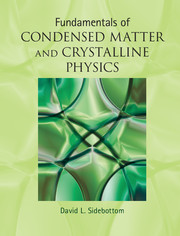 Fundamentals of Condensed Matter and Crystalline Physics
Fundamentals of Condensed Matter and Crystalline Physics Book contents
- Frontmatter
- Contents
- Preface
- Permission Disclosures
- Part I Structure
- Part II Scattering
- Part III Dynamics
- 9 Liquid dynamics
- 10 Crystal vibrations
- 11 Thermal properties
- 12 Electrons: the free electron model
- 13 Electrons: band theory
- 14 Bulk dynamics and response
- Part IV Transitions
- Appendix Toolbox
- Glossary
- References
- Index
- References
11 - Thermal properties
from Part III - Dynamics
Published online by Cambridge University Press: 05 August 2012
- Frontmatter
- Contents
- Preface
- Permission Disclosures
- Part I Structure
- Part II Scattering
- Part III Dynamics
- 9 Liquid dynamics
- 10 Crystal vibrations
- 11 Thermal properties
- 12 Electrons: the free electron model
- 13 Electrons: band theory
- 14 Bulk dynamics and response
- Part IV Transitions
- Appendix Toolbox
- Glossary
- References
- Index
- References
Summary
Introduction
In the previous chapter, we examined the elastic nature of a crystal and replaced the notion of atoms as independent harmonic oscillators with the concept of phonons as quantized pieces of elastic waves propagating within a crystal. In this chapter we bolster our confidence in the reality of these phonons by examining two thermal properties of a crystal: its specific heat and its thermal conductivity. At low temperatures, the specific heat of a crystal decreases as the cube of the temperature. A model (attributed to Einstein) based only on independent harmonic oscillators is unable to account for this particular low temperature dependence, while the Debye model, involving a population of phonons, properly accounts for the temperature dependence. Likewise, the thermal conductivity of a crystal can only be understood using the phonon picture. The thermal conductivity exhibits a sharp division in its temperature dependence between a T 3 variation at low temperatures and a 1/T dependence at high temperatures. This division stems from the nature of phonon–phonon collisions, which are only truly successful in retarding heat flow at high temperatures where so-called Umklapp processes dominate. In these collisions, the resultant phonon emerging from the collision extends beyond the boundaries of the Brillouin zone and suffers strong Bragg scattering by the lattice.
Specific heat of solids
Consider a crystal maintained at some finite temperature. Clearly the crystal contains energy in the form of lattice vibrations for which we have now developed two, self-consistent pictures. In one picture, we view this energy as stored in atoms that act as local harmonic oscillators. In the other picture, the energy is stored in a large population of phonons. The phonons appear in a variety of energies consistent with both the dispersion relation and the restricted set of allowed wave vectors imposed by the finite size of the crystal and the boundary of the first Brillouin zone.
- Type
- Chapter
- Information
- Fundamentals of Condensed Matter and Crystalline PhysicsAn Introduction for Students of Physics and Materials Science, pp. 182 - 200Publisher: Cambridge University PressPrint publication year: 2012


